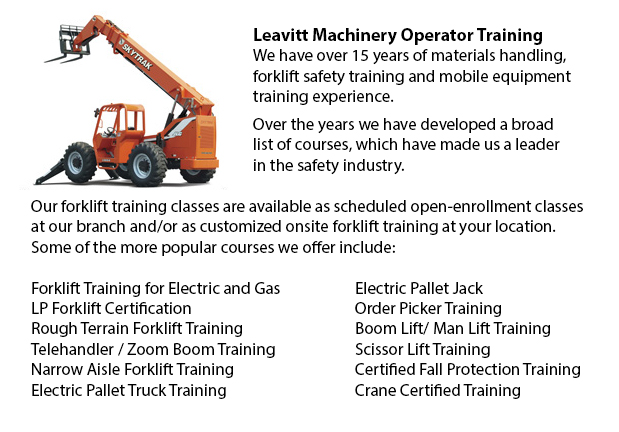
Ottawa Zoom Boom Training - Zoom Boom Training focuses on properly training prospective operators on variable reach forklifts. The training objectives consist of gaining the knowledge of the equipments physics and to define the job of the operator. This program follows North American safety standards for lift trucks. Zoom boom training and certification is obtainable at the company's location or at our site, provided there are a minimum number of trainees. Certification received upon successful completion is valid for three years.
A telescopic handler (also known as a telehandler) is similar in some ways to both a forklift and a crane. It is a useful machinery constructed with a telescopic boom which could lift upwards and extend forward. Various attachments can be fitted on the end of the boom, such as pallet forks, bucket, muck grab or lift table. It is popular in industry and agriculture settings.
Telehandlers are most usually utilized together with the fork attachment to be able to shuttle loads. The units have the advantage that they could reach places not accessible to standard forklifts. Telehandlers could remove palletized loads from within a trailer and placing them on high places like rooftops. For some applications, they could be a lot more practical and efficient than a crane.
The disadvantage of the telehandler is its unsteadiness when lifting loads that are heavier. When the boom extends with a load, the unit becomes ever more unstable. Counterweights in the rear help, but do not solve the problem. When the working radius increases, the lifting capacity quickly decreases. Several equipment come along with front outriggers which extend the lifting capacity while the machinery is stationary.
A load chart helps the operator to know whether a given load is too heavy. Factors like for example boom angle and height and load weight are calculated. Some telehandlers have sensors which cut off further control or provide a warning if the unit is in danger of destabilizing.
-
Ottawa Boom Lift Ticket
Ottawa Boom Lift Ticket - Boom Lifts are a table lift piece of equipment which could be lifted or lowered to varying heights, making this apparatus a useful tool for many manufacturing purposes. There are some unique types of Boom Lift consisting of... More -
Ottawa Boom Lift Operator Training
Ottawa Boom Lift Operator Training - The cherry picker work platform is a kind of work platform, which will typically have a bucket or platform at the hydraulic lifting system's end. The device is also referred to as a man lift, boom lift, basket cra... More -
Aerial Lift / Boom Lift / Man Lift / Scissor Lift Training in Ottawa
Scissor lifts are forklift tables which raise objects and people and supplies vertically. They are normally utilized in industrial, construction and commercial environments. A common use of scissor lifts is for lifting or lowering construction suppli... More -
Ottawa Crane Certification
Ottawa Crane Certification - The Crane Certification training program covers content suggested by industry concerning the safe and efficient operation of cranes. Individuals training would know the following: pre-operational, operational and post ope... More -
Ottawa Heavy Equipment Training Courses
Ottawa Heavy Equipment Training Courses - The first step required to take when selecting heavy equipment operator courses is determining the capacity you wish to work with heavy machinery. Like for example, you can take courses that will teach you ho... More -
Ottawa Fall Protection Ticket
Ottawa Fall Protection Ticket - Fall-related accidents are the number one reason of death in the construction trade. The potential for fall accidents very much increases based on the kind of work which is being completed within your workplace. So, be... More -
Ottawa Telehandler Operator Training
Ottawa Telehandler Operator Training - Telescopic handler Forklifts or telehandler forklifts are common industrial machinery seen in various construction business settings. The telehandler is a useful machine and makes for a valuable tool that can be... More -
Fall Protection Training in Ottawa
Regrettably, there is a large number of workplace injuries linked to falling and lots of fall-related deaths reported each year. Lots of these instances might have been prevented by having proper measures in place, offering proper training and equipp... More

Forklift Certification Ottawa
TOLL FREE: 1-888-254-6157
Ottawa, Ontario
forkliftcertificationottawa.com
Email Us
About Us


